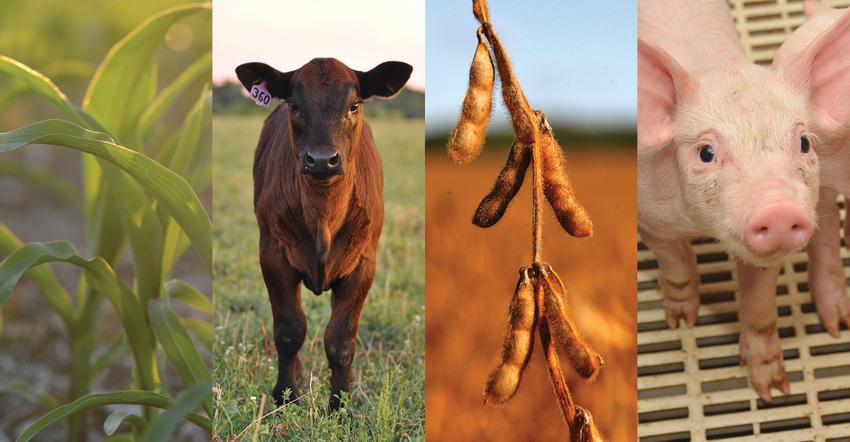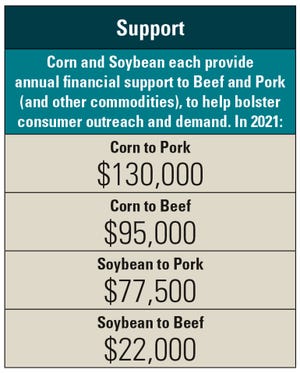April 6, 2022

Scrolling through Twitter the other day, I came across a group of farmers talking about farm organizations and how they spend money.
One of the gentlemen asserted that when a farmer gives money to an ag organization, that group uses it to partner with another coalition, which passes it to another organization that uses it to fund a project with another group, and by the end, the money is worth half what it was when they started.
Whether you agree with that may depend on your state, your crop and your experience.
But I’ve spent the last several weeks diving deep (very deep) into Illinois ag commodity funding, and one thing is clear to me: Working together makes the dollars worth more — not less.
Looking back
Historically, Illinois commodity organizations have a spotty record of working together. Farmers have complained because either they aren’t involved and therefore don’t understand, or they see lavish travel arrangements, or they don’t believe in the same return on investment. They may have a genuine beef (no pun intended and not specific to beef) about how checkoff dollars are spent.
Today, farmers in Illinois are fortunate to operate under exceptional commodity leadership. All four major commodity organizations are led by venerable executives and farmers who want to get along and pool resources.
Rod Weinzierl, IL Corn’s longtime executive director, recently observed that an organization reflects the personality of its highest-paid employee, a fact I’ve mulled over ever since and applied with success to every group from our company to my church.
Moments later, Weinzierl told me IL Corn doesn’t put its logo on everything it funds. “The goal is to get the job done, not be flashy,” he said. And if ever there were a quote that summed up Weinzierl, it might be that. He’s led IL Corn for 28 years, met the goals, didn’t trouble with fanfare. It’s been unsurprisingly effective.
John Lumpe’s two-year tenure at the Illinois Soybean Association has been marked by building relationships and reorganizing priorities. The organization saved a million dollars last year alone by cutting back agency contractors and doing the work internally.
Jennifer Tirey has led the Illinois Pork Producers Association since 2015. She’s strategic and careful, and concerned about supporting agriculture in Illinois. She takes her members’ struggles to heart.
Over at the Illinois Beef Association, Josh St. Peters is the new guy on the block, just 13 months in. He’s got a deep internal knowledge of Illinois, agriculture, beef and politics, and he knows all the players, down to the county level. He’ll tell you he took the job because of the three aforementioned leaders.
Those relationships are just like a farm family: There’s give and take. And good times and bad. But Weinzierl says, “Everything is clicking really well right now between the organizations.”
Case in point: IL Corn has been funding Precision Conservation Management, an ongoing conservation research and promotion program. Illinois Soybean jumped in to help fund this year, and what was a program for part of the state is now available for the whole state — because they worked together.
The soybean association could’ve spent a couple of million dollars and started over with its own conservation project. Instead, it used a smaller amount of the checkoff dollar in combination with corn’s checkoff dollar to give greater power than when they’re separate. That’s smarter.
Very few farmers are a one-commodity operation, and it makes sense for the checkoff organizations to act like it.
Teamwork
Which brings us back to a tweet. And a question about money.
In Illinois, corn and soybeans are the giants. Illinois farmers raise nearly $12 billion of corn and nearly $9 billion of soybeans. By contrast, they raise $1.3 billion of pork and $671 million of beef. This is what our land and climate are suited for and what our farmers have chosen to raise.
The value of those commodities is obviously reflected in the checkoff dollars each generates. For the state, corn brings in nearly $14 million; soybeans, $16.7 million; pork, $1.3 million; and beef, $600,000.
But those pigs and cows eat corn and beans. And beef and pork are a lot closer to the consumer than corn and soybeans are, and their message resonates better. So Corn and Soy help them boost consumer outreach and demand.
Here’s how that looked in 2021:
Corn gave $130,000 to Pork
Corn gave $95,000 to Beef
Soybean gave $77,500 to Pork
Soybean gave $22,000 to Beef
A large portion of the money Corn and Soy give to Pork is for Pork Power, a program that buys ground pork and donates it to food banks across Illinois. Last year they donated more than 64,000 pounds of pork to nine food banks.
That’s a direct use of the funds that benefits pork producers — and the corn and soybean farmers who raise the feed — while also helping feed people. The dollars are amplified, not reduced.

And both Pork and Beef use dollars to target communications in social media through geofencing — reaching just the right consumer.
As Weinzierl says, Beef and Pork can do things Corn and Soy can’t. “But we can learn from them. They gain experience, we gain insight, they help us figure out where it can work for us.”
Weinzierl says Corn and Soy need Beef and Pork to be strong partners in Springfield, too.
“We will do anything we can to make them stronger, so Illinois ag is stronger,” he says. “Illinois agriculture’s relevancy in Illinois is our biggest concern.”
And honestly, that ought to be the biggest concern for all of us.
Comments? Send email to [email protected]. For more on how the Illinois commodity organizations are spending checkoff dollars and working together, click here.
You May Also Like




